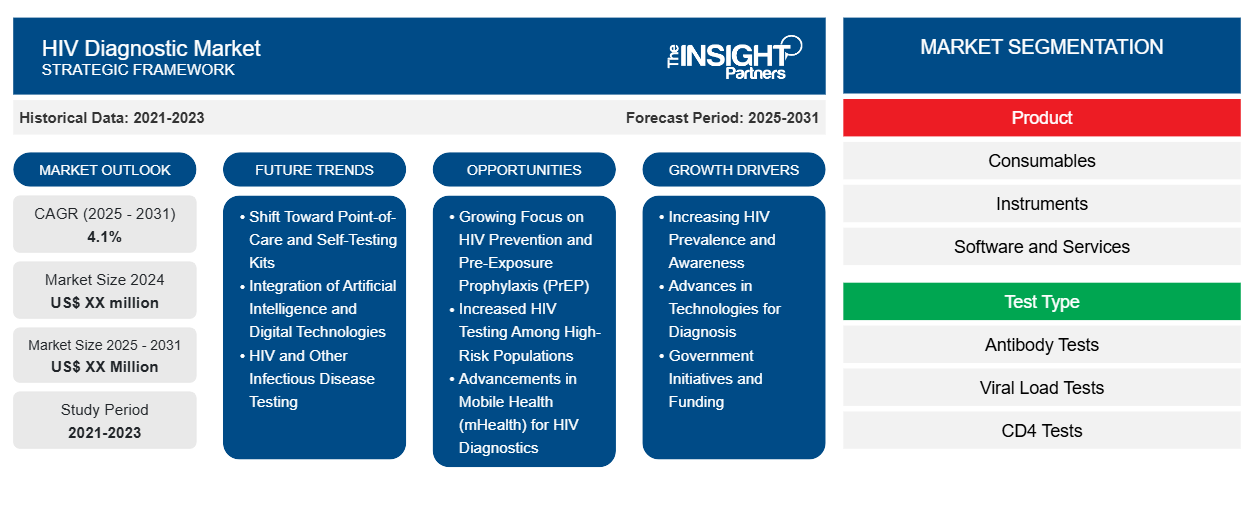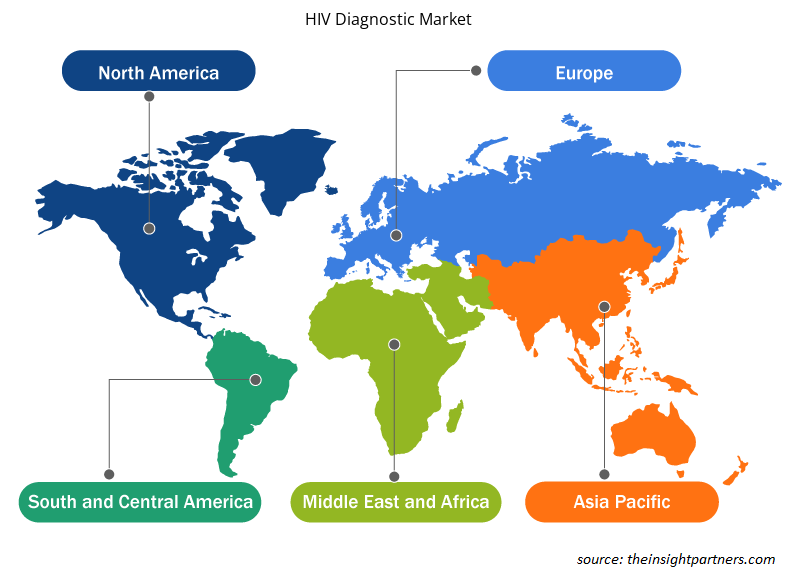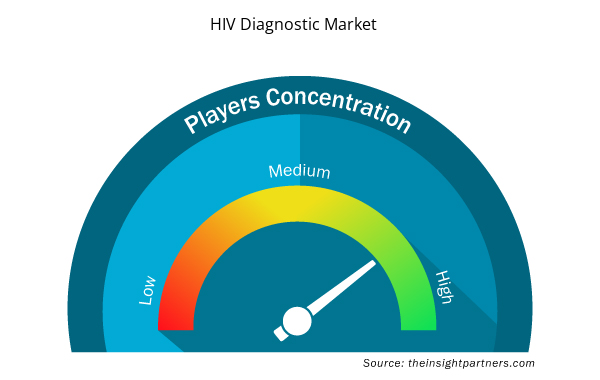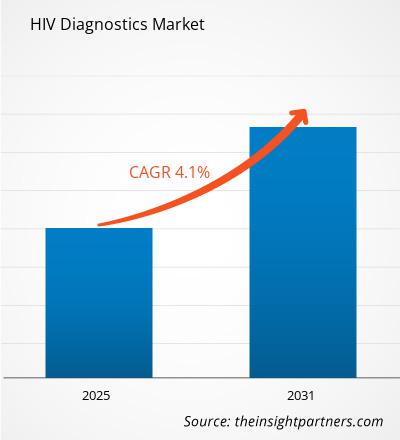Le marché du diagnostic du VIH devrait enregistrer un TCAC de 4,1 % de 2025 à 2031, avec une taille de marché passant de XX millions USD en 2024 à XX millions USD d'ici 2031.
Le rapport sur le marché du diagnostic du VIH couvre l'analyse par produit (consommables, instruments, logiciels et services) ; type de test (tests d'anticorps, tests de charge virale, tests CD4, tests de diagnostic précoce chez le nourrisson, tests d'identification virale) ; utilisateur final (laboratoires de diagnostic, hôpitaux, banques du sang, établissements de soins à domicile et autres utilisateurs finaux) et géographie (Amérique du Nord, Europe, Asie-Pacifique, Amérique du Sud et Amérique centrale). L'analyse mondiale est ensuite ventilée par région et par principaux pays. Le rapport offre la valeur en dollars américains pour l'analyse et les segments ci-dessus.
Objet du rapport
Le rapport sur le marché du diagnostic du VIH, publié par The Insight Partners, vise à décrire le paysage actuel et la croissance future, les principaux moteurs, les défis et les opportunités. Il fournira des informations aux différents acteurs du secteur, notamment :
- Fournisseurs/fabricants de technologies : pour comprendre l’évolution de la dynamique du marché et connaître les opportunités de croissance potentielles, leur permettant de prendre des décisions stratégiques éclairées.
- Investisseurs : réaliser une analyse complète des tendances concernant le taux de croissance du marché, les projections financières du marché et les opportunités qui existent tout au long de la chaîne de valeur.
- Organismes de réglementation : Réglementer les politiques et les activités de police sur le marché dans le but de minimiser les abus, de préserver la confiance des investisseurs et de maintenir l’intégrité et la stabilité du marché.
Segmentation du marché du diagnostic du VIH
Produit
- Consommables
- Instruments
- Logiciels et services
Type de test
- Tests d'anticorps
- Tests de charge virale
- Tests CD4
- Tests pour le diagnostic précoce du nourrisson
- Tests d'identification virale
Utilisateur final
- Laboratoires de diagnostic
- Hôpitaux
- Banques du sang
- Paramètres de soins à domicile
- Autre utilisateur final
Personnalisez ce rapport en fonction de vos besoins
Vous bénéficierez d'une personnalisation gratuite de n'importe quel rapport, y compris des parties de ce rapport, ou d'une analyse au niveau des pays, d'un pack de données Excel, ainsi que de superbes offres et réductions pour les start-ups et les universités.
Marché du diagnostic du VIH : perspectives stratégiques

- Obtenez les principales tendances clés du marché de ce rapport.Cet échantillon GRATUIT comprendra une analyse de données, allant des tendances du marché aux estimations et prévisions.
Facteurs de croissance du marché du diagnostic du VIH
- Augmentation de la prévalence et de la sensibilisation au VIH : L’augmentation de la prévalence du VIH, notamment dans des régions comme l’Afrique subsaharienne, l’Asie et l’Europe de l’Est, est un facteur déterminant pour le marché du diagnostic du VIH. La sensibilisation accrue au VIH et à ses modes de transmission entraîne une demande accrue de tests de routine, de diagnostic précoce et de suivi de la maladie. Le besoin d’outils de diagnostic plus innovants et plus précis pour mieux gérer l’épidémie de VIH s’accroît donc.
- Progrès technologiques en matière de diagnostic : Les avancées technologiques en matière de diagnostic comprennent les tests au point de service (POC), les tests de diagnostic rapide (TDR) et les tests moléculaires. Elles ont considérablement amélioré l'efficacité, la rapidité et la précision du diagnostic du VIH. Grâce à ces innovations, des tests plus rapides et plus accessibles sont possibles, non seulement dans les milieux riches en ressources, mais aussi dans ceux qui en ont moins. L'avènement des kits d'autotest, par exemple, facilite et simplifie le dépistage du VIH, favorisant ainsi la croissance du marché.
- Initiatives et financements gouvernementaux : Les gouvernements et les organisations internationales, notamment l’Organisation mondiale de la Santé (OMS) et le Plan d’urgence du Président des États-Unis pour la lutte contre le sida (PEPFAR), investissent massivement dans les programmes de prévention et de diagnostic du VIH. Ces programmes visent à accroître l’accès à des tests de dépistage du VIH abordables et à améliorer les technologies diagnostiques, ce qui accroît la demande d’outils de diagnostic du VIH. Le financement de la recherche et les campagnes de santé publique contribuent également à améliorer les diagnostics du VIH à l’échelle mondiale.
Tendances futures du marché du diagnostic du VIH
- Évolution vers les tests au point de service et les kits d'autotest : Une tendance clé sur le marché du diagnostic du VIH est la demande croissante de tests au point de service et de kits d'autotest. Les diagnostics au point de service permettent d'obtenir rapidement des résultats, permettant ainsi aux patients d'effectuer des autotests en toute confidentialité dans des lieux isolés, y compris dans des zones reculées ou difficiles d'accès. Les kits d'autotest ont connu une croissance significative grâce à des approches innovantes de méthodes non invasives telles que les tests de salive.
- Intégration de l'intelligence artificielle et des technologies numériques : L'IA et les technologies numériques sont de plus en plus utilisées dans le diagnostic du VIH. Les algorithmes d'IA peuvent améliorer la précision des résultats des tests, analyser plus efficacement les données des patients et contribuer à prédire la progression du VIH. De plus, des applications mobiles de santé sont en cours de développement pour faciliter le suivi des résultats des tests, gérer les schémas thérapeutiques et informer les patients. Cette transformation numérique du diagnostic améliore la prise en charge des patients et leur accessibilité, notamment dans les contextes à faibles ressources.
- Dépistage du VIH et d'autres maladies infectieuses : L'intégration du diagnostic du VIH avec d'autres tests de maladies infectieuses, comme la tuberculose et l'hépatite, sur une plateforme unique est de plus en plus courante. Cette intégration réduit les coûts et les délais de dépistage de plusieurs maladies. De plus, elle offre des solutions de dépistage complètes, avantageuses dans les régions où les co-infections sont fréquentes. L'association de plateformes de dépistage permet d'améliorer l'observance thérapeutique et la prise en charge des comorbidités chez les patients atteints du VIH.
Opportunités de marché pour le diagnostic du VIH
- Accent croissant sur la prévention du VIH et la prophylaxie pré-exposition (PrEP) : Avec l'attention croissante portée à la prévention du VIH et l'augmentation du nombre de personnes ayant recours à la prophylaxie pré-exposition (PrEP), l'industrie du diagnostic aura l'opportunité de développer et de commercialiser des tests permettant de suivre l'efficacité de la PrEP chez les populations à haut risque. Le dépistage systématique du VIH est un élément important de tout programme de PrEP ; par conséquent, la demande de solutions diagnostiques adaptées à cette nouvelle approche préventive en plein essor augmentera, créant ainsi des sources de revenus supplémentaires pour les entreprises du marché du diagnostic du VIH.
- Augmentation du dépistage du VIH parmi les populations à haut risque : La nécessité d'un dépistage périodique du VIH est de plus en plus reconnue chez les personnes à haut risque, telles que les HSH, les travailleurs du sexe, les consommateurs de drogues injectables et les personnes ayant de multiples partenaires sexuels. À mesure que les campagnes de sensibilisation se poursuivent auprès de ces groupes à risque, la demande de services de diagnostic du VIH accessibles et confidentiels ne peut qu'augmenter. Cela offre aux prestataires de services de diagnostic une voie potentielle pour proposer à ces populations mal desservies des solutions de dépistage spécifiques.
- Progrès de la santé mobile (mHealth) pour le diagnostic du VIH : La technologie mHealth offre une formidable opportunité pour le diagnostic du VIH. Avec la généralisation des smartphones, les plateformes et applications de santé mobiles peuvent être utilisées pour la gestion du dépistage du VIH, les rappels de traitement et l'information des patients. Les solutions mHealth, intégrées aux appareils de diagnostic pour suivre et analyser le statut VIH, ouvrent de nouvelles perspectives pour le développement des soins et du diagnostic du VIH, notamment dans les zones reculées aux infrastructures de santé limitées.
Aperçu régional du marché du diagnostic du VIH
Les tendances et facteurs régionaux influençant le marché du diagnostic du VIH tout au long de la période de prévision ont été analysés en détail par les analystes d'Insight Partners. Cette section aborde également les segments et la géographie du marché du diagnostic du VIH en Amérique du Nord, en Europe, en Asie-Pacifique, au Moyen-Orient et en Afrique, ainsi qu'en Amérique du Sud et en Amérique centrale.

- Obtenez les données régionales spécifiques au marché du diagnostic du VIH
Portée du rapport sur le marché du diagnostic du VIH
| Attribut de rapport | Détails |
|---|---|
| Taille du marché en 2024 | XX millions de dollars américains |
| Taille du marché d'ici 2031 | XX millions de dollars américains |
| TCAC mondial (2025 - 2031) | 4,1% |
| Données historiques | 2021-2023 |
| Période de prévision | 2025-2031 |
| Segments couverts | Par produit
|
| Régions et pays couverts | Amérique du Nord
|
| Leaders du marché et profils d'entreprises clés |
|
Densité des acteurs du marché du diagnostic du VIH : comprendre son impact sur la dynamique des entreprises
Le marché du diagnostic du VIH connaît une croissance rapide, portée par une demande croissante des utilisateurs finaux, due à des facteurs tels que l'évolution des préférences des consommateurs, les avancées technologiques et une meilleure connaissance des avantages du produit. Face à cette demande croissante, les entreprises élargissent leur offre, innovent pour répondre aux besoins des consommateurs et capitalisent sur les nouvelles tendances, ce qui alimente la croissance du marché.
La densité des acteurs du marché désigne la répartition des entreprises opérant sur un marché ou un secteur particulier. Elle indique le nombre de concurrents (acteurs) présents sur un marché donné par rapport à sa taille ou à sa valeur marchande totale.
Les principales entreprises opérant sur le marché du diagnostic du VIH sont :
- Abbott Santé
- Alere Inc
- Bristol-Myers Squibb
- Abbvie Inc
- Gilead Sciences
- Janssen Therapeutics
Avertissement : Les entreprises répertoriées ci-dessus ne sont pas classées dans un ordre particulier.

- Obtenez un aperçu des principaux acteurs du marché du diagnostic du VIH
Principaux arguments de vente
- Couverture complète : Le rapport couvre de manière exhaustive l’analyse des produits, des services, des types et des utilisateurs finaux du marché du diagnostic du VIH, offrant un paysage holistique.
- Analyse d’experts : Le rapport est compilé sur la base d’une compréhension approfondie des experts et analystes du secteur.
- Informations à jour : Le rapport garantit la pertinence commerciale en raison de sa couverture des informations récentes et des tendances des données.
- Options de personnalisation : ce rapport peut être personnalisé pour répondre aux exigences spécifiques des clients et s'adapter de manière appropriée aux stratégies commerciales.
Le rapport de recherche sur le marché du diagnostic du VIH peut donc contribuer à décrypter et à comprendre le contexte et les perspectives de croissance du secteur. Malgré quelques inquiétudes légitimes, les avantages globaux de ce rapport l'emportent généralement sur ses inconvénients.
- Analyse historique (2 ans), année de base, prévision (7 ans) avec TCAC
- Analyse PEST et SWO
- Taille du marché Valeur / Volume - Mondial, Régional, Pays
- Industrie et paysage concurrentiel
- Ensemble de données Excel


- Integrated Platform Management System Market
- Organoids Market
- Smart Mining Market
- Fertilizer Additives Market
- Smart Parking Market
- Explosion-Proof Equipment Market
- Employment Screening Services Market
- Non-Emergency Medical Transportation Market
- Electronic Health Record Market
- Mobile Phone Insurance Market

Report Coverage
Revenue forecast, Company Analysis, Industry landscape, Growth factors, and Trends

Segment Covered
This text is related
to segments covered.

Regional Scope
North America, Europe, Asia Pacific, Middle East & Africa, South & Central America

Country Scope
This text is related
to country scope.
Questions fréquemment posées
The report can be delivered in PDF/PPT format; we can also share excel dataset based on the request.
The leading players operating in the HIV Diagnostics Market include Abbott Healthcare, Alere Inc, Bristol-Myers Squibb, Abbvie Inc, Gilead Sciences, Janssen Therapeutics, BD Biosciences, Beckman Coulter, PointCare Technologies Inc.
The major factors driving the HIV Diagnostics Market are Increasing HIV Prevalence and Awareness, Advances in Technologies for Diagnosis, and Government Initiatives and Funding
The key future trends of the market are Shift Toward Point-of-Care and Self-Testing Kits, Integration of Artificial Intelligence and Digital Technologies, and HIV and Other Infectious Disease Testing
Some of the customization options available based on the request are an additional 3–5 company profiles and country-specific analysis of 3–5 countries of your choice. Customizations are to be requested/discussed before making final order confirmation, as our team would review the same and check the feasibility.
Trends and growth analysis reports related to Life Sciences : READ MORE..
The List of Companies
- Abbott Healthcare
- Alere Inc
- Brsitol-Myers Squibb
- Abbvie Inc
- Gilead Sciences
- Janssen Therapeutics
- BD Biosciences
- Beckman Coulter
- PointCare Technologies Inc
- Roche Diagnostics
The Insight Partners performs research in 4 major stages: Data Collection & Secondary Research, Primary Research, Data Analysis and Data Triangulation & Final Review.
- Data Collection and Secondary Research:
As a market research and consulting firm operating from a decade, we have published and advised several client across the globe. First step for any study will start with an assessment of currently available data and insights from existing reports. Further, historical and current market information is collected from Investor Presentations, Annual Reports, SEC Filings, etc., and other information related to company’s performance and market positioning are gathered from Paid Databases (Factiva, Hoovers, and Reuters) and various other publications available in public domain.
Several associations trade associates, technical forums, institutes, societies and organization are accessed to gain technical as well as market related insights through their publications such as research papers, blogs and press releases related to the studies are referred to get cues about the market. Further, white papers, journals, magazines, and other news articles published in last 3 years are scrutinized and analyzed to understand the current market trends.
- Primary Research:
The primarily interview analysis comprise of data obtained from industry participants interview and answers to survey questions gathered by in-house primary team.
For primary research, interviews are conducted with industry experts/CEOs/Marketing Managers/VPs/Subject Matter Experts from both demand and supply side to get a 360-degree view of the market. The primary team conducts several interviews based on the complexity of the markets to understand the various market trends and dynamics which makes research more credible and precise.
A typical research interview fulfils the following functions:
- Provides first-hand information on the market size, market trends, growth trends, competitive landscape, and outlook
- Validates and strengthens in-house secondary research findings
- Develops the analysis team’s expertise and market understanding
Primary research involves email interactions and telephone interviews for each market, category, segment, and sub-segment across geographies. The participants who typically take part in such a process include, but are not limited to:
- Industry participants: VPs, business development managers, market intelligence managers and national sales managers
- Outside experts: Valuation experts, research analysts and key opinion leaders specializing in the electronics and semiconductor industry.
Below is the breakup of our primary respondents by company, designation, and region:

Once we receive the confirmation from primary research sources or primary respondents, we finalize the base year market estimation and forecast the data as per the macroeconomic and microeconomic factors assessed during data collection.
- Data Analysis:
Once data is validated through both secondary as well as primary respondents, we finalize the market estimations by hypothesis formulation and factor analysis at regional and country level.
- Macro-Economic Factor Analysis:
We analyse macroeconomic indicators such the gross domestic product (GDP), increase in the demand for goods and services across industries, technological advancement, regional economic growth, governmental policies, the influence of COVID-19, PEST analysis, and other aspects. This analysis aids in setting benchmarks for various nations/regions and approximating market splits. Additionally, the general trend of the aforementioned components aid in determining the market's development possibilities.
- Country Level Data:
Various factors that are especially aligned to the country are taken into account to determine the market size for a certain area and country, including the presence of vendors, such as headquarters and offices, the country's GDP, demand patterns, and industry growth. To comprehend the market dynamics for the nation, a number of growth variables, inhibitors, application areas, and current market trends are researched. The aforementioned elements aid in determining the country's overall market's growth potential.
- Company Profile:
The “Table of Contents” is formulated by listing and analyzing more than 25 - 30 companies operating in the market ecosystem across geographies. However, we profile only 10 companies as a standard practice in our syndicate reports. These 10 companies comprise leading, emerging, and regional players. Nonetheless, our analysis is not restricted to the 10 listed companies, we also analyze other companies present in the market to develop a holistic view and understand the prevailing trends. The “Company Profiles” section in the report covers key facts, business description, products & services, financial information, SWOT analysis, and key developments. The financial information presented is extracted from the annual reports and official documents of the publicly listed companies. Upon collecting the information for the sections of respective companies, we verify them via various primary sources and then compile the data in respective company profiles. The company level information helps us in deriving the base number as well as in forecasting the market size.
- Developing Base Number:
Aggregation of sales statistics (2020-2022) and macro-economic factor, and other secondary and primary research insights are utilized to arrive at base number and related market shares for 2022. The data gaps are identified in this step and relevant market data is analyzed, collected from paid primary interviews or databases. On finalizing the base year market size, forecasts are developed on the basis of macro-economic, industry and market growth factors and company level analysis.
- Data Triangulation and Final Review:
The market findings and base year market size calculations are validated from supply as well as demand side. Demand side validations are based on macro-economic factor analysis and benchmarks for respective regions and countries. In case of supply side validations, revenues of major companies are estimated (in case not available) based on industry benchmark, approximate number of employees, product portfolio, and primary interviews revenues are gathered. Further revenue from target product/service segment is assessed to avoid overshooting of market statistics. In case of heavy deviations between supply and demand side values, all thes steps are repeated to achieve synchronization.
We follow an iterative model, wherein we share our research findings with Subject Matter Experts (SME’s) and Key Opinion Leaders (KOLs) until consensus view of the market is not formulated – this model negates any drastic deviation in the opinions of experts. Only validated and universally acceptable research findings are quoted in our reports.
We have important check points that we use to validate our research findings – which we call – data triangulation, where we validate the information, we generate from secondary sources with primary interviews and then we re-validate with our internal data bases and Subject matter experts. This comprehensive model enables us to deliver high quality, reliable data in shortest possible time.

 Obtenez un échantillon gratuit pour ce rapport
Obtenez un échantillon gratuit pour ce rapport